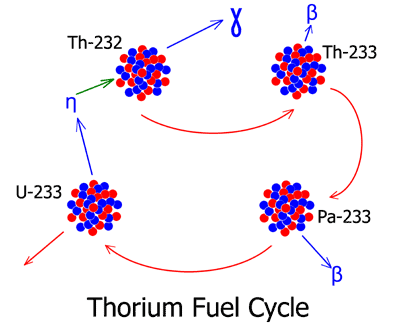Part 1
Although most nuclear reactors in the world today use fuel cycles based on the element uranium, it is also possible to use thorium as a source of nuclear energy with some types of nuclear reactors. A thorium-based fuel cycle has several advantages over one that is based on uranium, making it an increasingly attractive option to invest in from an energy production standpoint.

Thorium is element 90 in the periodic table. Like uranium, thorium is a naturally occurring actinide metal that is slightly radioactive when found in nature. Although as many as 33 different isotopes of thorium are possible, the thorium that is found in nature is mostly thorium-232. Thorium ores can be found in abundance all across the world, particularly in India and the western steppes of the US. Since there is currently little use for thorium from a commercial standpoint, there has been little effort to exploit these resources.

By itself, thorium-232 is not fissile, but if a neutron source is provided such as uranium-235, it can "jumpstart" thorium-232 into a fission chain reaction by causing it to absorb a neutron and become thorium-233. Thorium-233 has a half-life of twenty two minutes at the end of which it emits an electron, causing it to decay into proactinum-233. After 27 days, proactinum releases a second electron and becomes uranium-233.
232Th (n,γ) 233Th (β−) 233Pa (β−) 233U (n,2n)
Uranium-233 has a higher neutron yield than Uranium-235 when it undergoes fission, and therefore releases more energy per neutron absorbed. The decay of Uranium-233 would lead to the creation of numerous isotopes that would be useful from a medical and industrial standpoint and would be able to breed more uranium-233 within the reactor from the neutron irradiation of thorium-232. From a weapons-proliferation standpoint, the thorium-fuel cycle would be very difficult to divert into making fissile warheads. This is because proactinium can also decay into Uranium-232 which emits hard gamma radiation which is a hazard to people who would tamper with the reactor material in addition to the fact that although it is fissile within a reactor, it interferes with fast fission reactions like those within a thermonuclear bomb.
232Th (n,γ) 233Th (β−) 233Pa (n,2n) 232Pa (β−) 232U
Thorium-based fuel cycles have much in the way of economic potential and could be utilized by using off-the-shelf technology. The US experimented with thorium-based reactors during the molten-salt reactor experiment at the Oak Ridge National Laboratory during the mid-1960s until the project was abandoned in favor of uranium-based light water reactors for political reasons. Russia, China, and India are currently looking into the viability of thorium for nuclear energy production, and India is currently using thorium in its pressurized heavy water reactors (PHWRs) and its liquid metal fast breeder reactors (LMFBRs). Ideally, the full potential of thorium could be utilized in a liquid fluoride thorium reactor (LFTR) but it remains to be seen if the LFTR concept gains enough political momentum to allow it to be commerically realized.
No comments:
Post a Comment